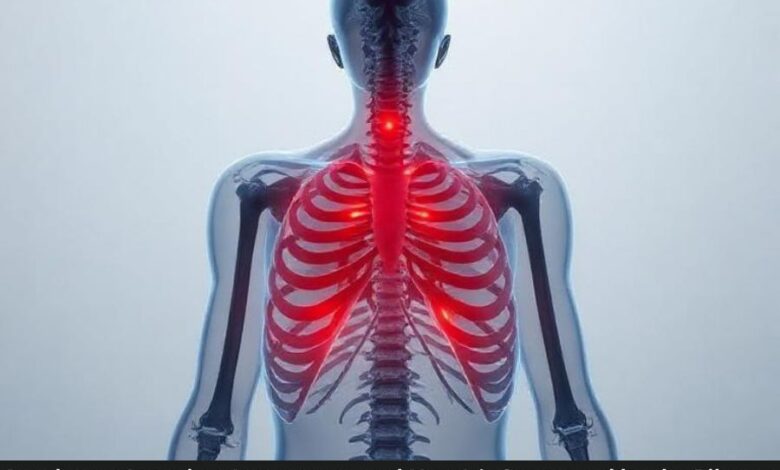Apothorax: Location, Importance and How It’s Supported by the Ribcage

The human body is a complex system filled with fascinating structures, and one of the lesser-known but essential anatomical regions is the apothorax. While many people are familiar with the thorax — the chest area containing the heart and lungs — the apothorax often remains misunderstood. Yet, this region plays a crucial role in respiration, organ protection, and overall body mechanics.
If you’ve ever wondered what lies between your ribs and diaphragm, or how this area impacts your breathing, you’re about to get a clear and simple explanation.
What Is the Apothorax?
Definition and Meaning
The apothorax refers to the anatomical region located between the lower ribs and the diaphragm. Although it isn’t commonly highlighted in everyday biology discussions, it is considered part of the lower thoracic cavity.
How the Apothorax Differs from the Thorax
While the thorax includes the entire chest cavity, the apothorax is a sub-region within it — specifically the lower section that interacts closely with both the lungs and diaphragm.
Anatomical Boundaries
- Upper boundary: Lower ribs
- Lower boundary: Diaphragm
- Lateral boundary: Ribcage
- Internal contents: Portions of the lungs, nerves, blood vessels
Location of the Apothorax
Position Between the Ribs and Diaphragm
The apothorax sits right above the diaphragm — the large dome-shaped muscle responsible for breathing — and below the middle thorax.
Structures Found Within the Apothorax
- Lower segments of the lungs
- Intercostal muscles
- Small blood vessels and nerves
- Connective tissue
Relationship to Surrounding Organs
This region is tightly connected to the lungs, heart (indirectly), and diaphragm. It moves as you breathe, helping maintain airflow and protecting vital organs.
Importance of the Apothorax
Role in Breathing
The apothorax expands and contracts with each breath, making it essential for lung movement.
Protection of Vital Organs
The ribcage surrounding the apothorax shields sensitive structures like the lower lungs and respiratory muscles.
Support in Circulatory Function
Blood vessels passing through this region help maintain proper circulation to the lungs and other organs.
How the Ribcage Supports the Apothorax
Ribcage Structure
Ribs, Vertebrae, and Sternum
The ribcage is made of 12 pairs of ribs that connect to the vertebral column and sternum, forming a stable yet flexible shield.
Elasticity and Flexibility of the Ribcage
This flexibility allows the apothorax to expand during inhalation and contract during exhalation.
Ribcage Movements
Expansion During Inhalation
The ribs move upward and outward, creating more space for the lungs to fill with air.
Compression During Exhalation
The ribs return to their resting position, gently reducing lung volume and helping push air out.
How the Ribs Shield the Apothorax
Protection from External Impact
The ribcage prevents damage to the delicate lung tissues located within the apothorax.
Maintaining Internal Pressure
Stable pressure is essential for efficient breathing — the ribcage ensures that.
Functions of the Apothorax
Respiratory Functions
Housing Part of the Lungs
The lower lobes of the lungs extend into the apothorax, making it vital for breathing efficiency.
Contribution to Airflow and Oxygen Exchange
Smooth expansion in this area improves oxygen intake.
Circulatory Functions
Supporting Blood Flow Around the Heart
Blood vessels around this region assist in transporting oxygen-rich blood.
Helping Maintain Vascular Stability
The apothorax acts as a protective corridor for major vessels.
Mechanical Support
Space for Organ Movement
The apothorax allows organs to shift during breathing and digestion.
Role in Posture and Body Mechanics
Strong rib support helps maintain upper body stability.
Disorders Related to the Apothorax
Inflammation
Conditions like costochondritis can affect the surrounding muscles and cartilage.
Injury to the Ribs or Diaphragm
Trauma can disturb the apothorax region, causing breathing difficulties.
Breathing Difficulties
Weak intercostal muscles may affect this region’s function.
How to Keep the Apothorax Healthy
Breathing Exercises
Deep breathing improves airflow and strengthens the diaphragm.
Strengthening the Ribcage
Yoga, Pilates, and stretching help improve flexibility.
Maintaining Good Posture
Proper posture enhances lung expansion in the apothorax.
Key Differences Between Thorax and Apothorax
Anatomical Comparison
The thorax is the entire chest cavity; the apothorax is a smaller section within it.
Functional Distinctions
The apothorax interacts closely with the diaphragm and lower lungs, making it especially important for breathing.
Why Understanding the Apothorax Matters
Importance for Biology Students
Knowing this region helps in studying respiratory physiology.
Clinical Relevance
Doctors assess this area when evaluating breathing disorders or rib injuries.
Conclusion
The apothorax may not be the most famous anatomical term, but it plays a powerful role in breathing, organ protection, and body mechanics. Located between the ribs and diaphragm, it works as a supportive space that ensures your lungs expand and your vital organs stay protected. Understanding this region helps you appreciate how the ribcage, diaphragm, and lungs work together to keep you alive and healthy.
FAQs
1. Where exactly is the apothorax located?
It lies between the lower ribs and the diaphragm, forming part of the lower thoracic cavity.
2. Is the apothorax the same as the thorax?
No, the apothorax is a sub-region within the thorax.
3. Which organs are connected to the apothorax?
Parts of the lungs, blood vessels, and intercostal muscles.
4. Does the ribcage protect the apothorax?
Yes, the ribcage acts as a protective shield around it.
5. Can apothorax issues affect breathing?
Absolutely — inflammation or injury can reduce lung expansion.




